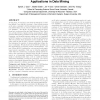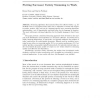917 search results - page 67 / 184 » Mining interesting sets and rules in relational databases |
CIKM
2005
Springer
14 years 2 months ago
2005
Springer
Data mining techniques frequently find a large number of patterns or rules, which make it very difficult for a human analyst to interpret the results and to find the truly interes...
DATAMINE
2006
13 years 9 months ago
2006
In order to allow for the analysis of data sets including numerical attributes, several generalizations of association rule mining based on fuzzy sets have been proposed in the li...
PKDD
2005
Springer
14 years 2 months ago
2005
Springer
It is generally believed that data mining results do not violate the anonymity of the individuals recorded in the source database. In fact, data mining models and patterns, in orde...
KDD
2007
ACM
14 years 9 months ago
2007
ACM
In this paper, we introduce and study the Minimum Consistent Subset Cover (MCSC) problem. Given a finite ground set X and a constraint t, find the minimum number of consistent sub...
GFKL
2006
Springer
14 years 21 days ago
2006
Springer
Stemming algorithms find canonical forms for inflected words, e. g. for declined nouns or conjugated verbs. Since such a unification of words with respect to gender, number, time, ...


